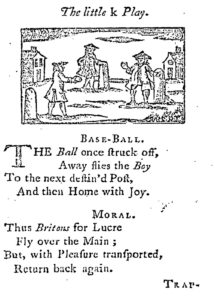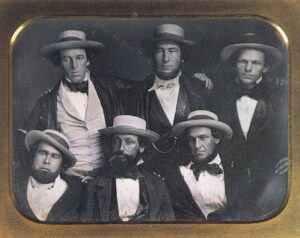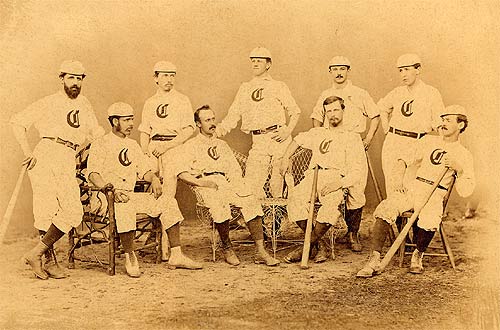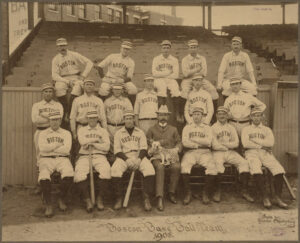The history of baseball has no parallel. Rich tradition. The intriguing mystery behind its origins. Heroes of almost mythic proportions.
So how did this “stick and ball” game come to be a cornerstone of American culture? An obsession passed down from grandfathers to grandkids for generations?
Well, grab a bag of peanuts. Have your glove handy. And, of course, keep your eye on the ball.
This is the history of baseball.
New York Base Ball
It’s September 11, 1845, in New York. Your city has spent the last two months recovering from its second devastating fire in a decade.
The sound of the exploding warehouse still rings in your ears.
As you skim over the morning paper, an announcement catches your eye. A game played yesterday. “Grown men playing games? At a time like this? In the NEWS??”
You dismiss it.
But the history of baseball is about to explode.
“Base-ball”, a simple bat and ball game with bases, had been a source of entertainment for children since at least the 1700’s.
In the states, “base-ball” had grown popular in the early 1800’s, taking on different forms and names in the many sections of the country.

The history of baseball begins to be found with this poem from A Little Pretty Pocket Book (wiki , Library of Congress) in 1744
Philadelphia saw “town ball” develop and inspire the formation of a club, the Olympic Club, in 1833. New Englanders preferred “round ball” or “the Massachusetts game” as it would eventually be called.
In New York, the game was still known as “base ball” and had been an outlet of organized exercise since the 1820’s.
The only thing was…the general population still saw it as a children’s game. Too many variations. Not enough action.
But one group of men was about to unintentionally change all that.
The game we have come to know and love throughout the history of baseball was about to start its journey into the hearts of people across the country.
The Knickerbockers
On September 23, 1845, a group of local “base ball” enthusiasts gathered at McCarthy’s Hotel in Hoboken, New Jersey to formally organize the Knickerbocker Base Ball Club.

The Knickerbocker Club was one of the first organized teams in the history of baseball
As part of their by-laws the club also published what would become known as the “Knickerbocker Rules“
These 20 rules would regulate their games in an effort to curb disputes and maintain gentlemanly conduct.
Two rules particularly revolutionized the history of baseball:
- Rule 10 – A ball knocked out of the field, or outside the range of the first and third base, is foul.
- Rule 13 – A player running the bases shall be out if the ball is in the hands of an adversary on the base or the runner is touched with it before he makes his base; it being understood, however, that in no instance is a ball to be thrown at him.
The other forms of the game generally allowed for the ball to be played wherever it was hit and for a fielder to throw the ball at a runner (“soaking”) to record an out.
These and other key rules would eventually prove to be what propelled the New York game of “base ball” to the forefront.
It’s been more than a month, now October 21, since you came across the first newspaper account of a base ball game.
A few weeks ago you noticed the Knickerbocker Club actually had the results of its first intrasquad game on October 6 published in the newspaper!
Today’s news has another announcement, and this one has you clearing your schedule.
A “Great Match at Base Ball” will be played today at two o’clock over in Hoboken at Elysian Field!
The Knickerbocker Club isn’t playing, but you’re sure that the clubs from New York and Brooklyn will provide plenty of entertainment…and your first good look at the “grown-up” side of this “time-honored” game.
| The New York Club |
|---|
| An 1887 interview with Knickerbocker co-founder William Wheaton suggests that the New York club may have been a group of gentlemen that would eventually organize as the Gotham Club in 1852. |
By the time you arrive at the field a large crowd of fans has assembled, undaunted by the cold wind howling out of the north.
As play moves along, the eight men from the New York club show their superiority. After only four innings, they have scored the required 21 “aces” and defeated the Brooklyn cricket players 24-4. A lop-sided but enthralling affair.
Three days later you make the trip over to Brooklyn for the return match.
Strategy. Defense. Competition.
You are hooked.
The following summer, on June 19, 1846, the first game in baseball history under the new “Knickerbocker Rules” would finally be played between the Knickerbockers and the New York club.
Though the game was played by their rules, the Knickerbockers suffered defeat in this first crude game, 23-1.
Definitely not the greatest home team performance in the history of baseball!
From a Game to a Pastime
After electing Daniel “Doc” Adams, a true “father of baseball”, as president of the club, the Knickerbockers spent the next few years playing intrasquad games.
But more importantly, they were introducing lasting changes to the game.
- On April 24, 1849 they took the field wearing collared white flannel shirts, blue wool pants with leather belts, and hats of straw–the first uniforms in the history of baseball!
- Doc Adams also “invented” the shortstop position in 1849. A player not assigned to a base was needed to retrieve the hand-made baseball from the outfielders (baseballs were getting hit further and further) and relay it to the pitcher.
In 1852, the next important step in the increasing popularity of baseball was made.
| The Spirit of 1854 |
|---|
| To celebrate the end of the season and the advancement of the game, the three teams gathered for dinner on December 15 at a restaurant called Fijux’s. The Knicks’ James Davis, considered the first baseball fanatic, performed an original song, Ball Days, which alluded to many of his teammates and rivals! |
The Knickerbockers found a rival.
The New York Gothams were formed, and the spirited match-ups between the two teams (though the Gothams wouldn’t claim their first victory until June 1, 1855) spurred the formation of another New York club, the Eagles, in 1854.
The teams even partied together!
In 1855 the rules of the game, which the three teams had come together and agreed upon the previous year, were published in the sports magazine, Spirit of the Times.
Even sandlots began to accommodate base ball games! (Talk about changing the history of baseball for the better!)
That year there were numerous clubs started outside the city of New York, and on June 2 Spirit of the Times claimed base ball was on its way to becoming the nation’s “most popular game.”
With 12 teams playing in the New York area in 1856, the New York Mercury newspaper put it another way.
On December 5, 1856 it (however prematurely) called baseball the “National Pastime.”
Going “National”
On January 22, 1857, the New York area clubs came together for one of the most significant meetings in the history of baseball–the First Baseball Convention.
Called together by the Knickerbockers (whose actual goal was to get rid of the rule that allowed an out to be made if the ball was caught after one bounce!), representatives from the teams assembled to set standard rules they could use when playing each other.Many rules were set at this first meeting and adopted later that year on March 7 as the game began to take a more defined shape.
Some of the more notable rules decided on were:
- Game consists of 9 innings instead of a race to 21 runs or “aces”
- Distance between bases is set at 90 feet (30 yards)
- Distance from home to the pitcher is set at 45 feet (15 yards)
The following year, in 1858, they officially organized the National Association of Base Ball Players.
This organization opened the door for expansion out of the New York area, with New Brunswick, New Jersey joining in 1858.
And it provided an avenue for baseball to showcase itself.
“Great Base Ball Match”
Imagine being a New York baseball “fan” during the summer of 1858. Watching amateur clubs playing occasional games on open fields.
Then the opportunity of a lifetime arrives.
The best players from New York have agreed to play the best players from Brooklyn in a series of three games. It’s being heralded as the “Great Base Ball Match”.
You don’t know it now, but this would be the first “all star” game in the history of baseball.
Not only will the best players be gathered together on one field, but they are going to charge money to see the game. To do this they will be playing at Fashion Course in Long Island–an enclosed horse race track!
After the first scheduled game is rained out, the game is finally able to be played a week later on July 20.
You and more than 7,500 others pay the 10 cents for admission and watch as the players arrive in carriages with team flags waving proudly.
You see your favorite Knickerbockers, catcher Charles de Bost and right fielder Harry Wright, teaming up with arch-rival pitcher from the Gothams, Tom Van Cott!
In the end, your favorites from New York triumph over the team from Brooklyn, 22-18 (and eventually the series, 2-1). But the excitement from seeing the best of the best, for the first time in baseball history, can’t be measured!
The next 10 years would be some of the most critical in baseball history.
Revolutionary developments like young Jim Creighton’s art of pitching in 1860 and the “tour” of the Excelsior Club of Brooklyn brought more attention to the game.
But the Civil War from 1861 to 1865 took its toll on the National Association of Base Ball Players.
By 1862 disbanding teams had almost left the membership without any teams outside of the New York area. In 1863 the total number of teams hit a low of 28.

Would the game endure?
This unknown team was declared to be one of the early champions in the history of baseball
That question was answered quickly.
When the war ended in 1865 membership exploded to nearly 100 teams. By 1867 there were more than 300 teams playing in 23 of the 37 states in the union, stretching from Washington, D.C. to Oregon!
1867 also saw the first really successful “road trip” in the history of baseball put together by the Nationals of Washington.
The Washington Nationals Tour
The previous July the Nationals had made a tour through Philadelphia and New York and lost 4 of 6 games. But in 1867 they were able to put together a much stronger team.
Then they scheduled a trip to the Midwest that would help change the history of baseball forever.
The team brought famous journalist, statistician and baseball promoter Henry Chadwick along for the tour as their official scorer.
They took out by train from Washington on July 11th and played their first game in Columbus, Ohio, against the Capital Club. They dominated the morning game and won 90-10.

The next day they took on the Cincinnati Club (which would later become known as the Red Stockings) at Union Grounds, winning 53-10 and giving them their only loss of the season.
After beating a Cincinnati Buckeye Club 88-12 on July 15, the Nationals traveled to Kentucky and beat the Louisville Club 82-21 on July 17 and went to Indianapolis and beat their club 106-21!
They seemed unstoppable!
The team traveled to St. Louis and beat the Union Club 113-26 in scorching heat on July 21. They then turned around the next day and beat the Empire Club 53-26 in a short six-inning game.
The final leg of their journey took them to Chicago, where their first opponent would be the Forest City Base Ball Club, featuring 17-year-old pitcher Albert Spalding.
After enduring a couple of 15-minute rain delays, the Nationals finally suffered their first loss of the trip at Dexter Park on July 25th, 29-23, to Forest City.
They recovered, however, and beat two other Chicago clubs, the Excelsiors (49-9) and the Atlantics (78-17), to finish their historic tour.
New York base ball had made its mark on the western clubs.
The Cincinnati Club took notice.
Going Pro
The Cincinnati Base Ball Club had been organized in 1866 by an alliance between the Resolutes (the original club name) and the Union Cricket Club.
Harry Wright, one of the cricket club members and son of a British cricket pro, became the captain of the club and began to bring professionalism out from “under the table”.
Many teams were finding ways to pay players in “secret”, but Wright saw nothing wrong with compensation and was intent on providing it in a way that would not draw public ire.
While winning all but one of their games in 1867, the single loss to the Nationals prompted Wright to become more aggressive in his pay the next year in order to compete at the highest level.
In an effort to offset the uneasiness the public had with the growing professionalism, the team moved to more spacious grounds and adopted the famous uniforms that would give them the unofficial name “Red Stockings”.

With a highly successful 1868 season, which saw them defeat their city rival Buckeyes in what amounted to a “winner take all” match, the Red Stockings set the example for how to navigate the professional waters.
In 1869 the National Association of Base Ball Players allowed a classification for professional teams.
Not surprisingly, Harry Wright embraced the opportunity, and the Red Stockings became what is often called the first completely professional team in the history of baseball. With his great eye for talent and game innovation (how about coming up with the relay throw?!) he put together one of the most dominant seasons the game would ever see, going 19-0 versus the other professional teams and 57-0 overall!
Unfortunately for baseball fans everywhere, the next season would be their last.
As profitability continued to be limited (even losing money in 1869 despite the team’s success) and hired out-of-town players began to display behavior unsuitable to the Cincinnati Ball Club, investors dropped their support.
The team disbanded on November 24, 1870.
Four of the core players then became part of the Boston Red Stockings that would eventually win four consecutive championships in the new National Association.
Ah, what could have been.
The Major Leagues
After the 1870 season, the professional teams decided they needed a separate league, and on March 4, 1871, formed the National Association of Professional Base Ball Players.
However, the association didn’t last long due to some critical problems:
- Only a $10 team entry fee allowed for small towns (Elizabeth, New Jersey; Middleton, Connecticut; Keokuk, Iowa?) which couldn’t support the travel of the big-city clubs with their gate receipts.
- Teams losing money had no incentive to continue their schedule later in the season and would often skip costly road trips.
- The Boston Red Stockings were so dominant (winning the championships from 1872 to 1875) that interest in the games declined.
On February 2, 1876, the strongest teams left to form the National League (the first “official” major league in the history of baseball), pretty much ending the National Association, as they tried to gain better control.

That control was immediately tested, as the Philadelphia Athletics and New York Mutuals failed to finish their schedules the first year.
They were promptly expelled from the league.
Over the next 25 years some major changes and developments would help propel the game into the 20th century:
- 1879 – the reserve clause was introduced to keep players from jumping teams and pushing up salaries after contracts expired each year (multi-year contracts were not common)
- 1879 – a rule was finally put in place that required all pitches to be called either balls or strikes
- 1880 – the first experiment in using lighting to play a night game between two department store teams in Massachusetts
- 1882 – a competing organization, the American Association, began playing, offering discounted tickets as well as alcoholic beverages and Sunday games (which enticed the Cincinnati Red Stockings, who had been expelled from the National Association for such practices)
- In 1882 the Chicago White Stockings (NL champions) and Cincinnati Red Stockings (AA champions) played a two-game series at the season’s end, with each team winning one game
- In 1884 the Providence Grays (NL champions) and New York Metropolitans (AA champions) played in three-game “Championship of the United States”, with the Grays sweeping the series
- 1884 – the Union Association was formed, without the reserve clause, but only lasted one season
- 1885 – Providence Grays’ shortstop, Arthur Irwin, adds padding to his fielding glove
- 1887 – the National League and American Association agree to play by same rules, with key changes being:
- strike zone set from knees to shoulders (“fair pitch”)
- hitter can no longer call for “high” or “low” pitch
- base on balls reduced to five balls
- base on balls counts as a hit (this season only)
- 1889 – Player’s League is formed, also without the reserve clause, but also lasted only one season
- 1891 – the National League absorbs the American Association, becoming a 12-team league known as the National League and the American Association of Base Ball Clubs and establishing the first “National Agreement”
- following 1899 season – the league officially and permanently changes its name to the National League and eliminates four clubs (from Baltimore, Cleveland, Louisville, and Washington)
- October 11, 1899 – the Western League, a minor league, changes its name to the American League and adds teams in Cleveland and Chicago’s south side.
- January 28, 1901 – the American League declares itself a major league and adds teams in Baltimore, Washington, Boston and Philadelphia while retaining teams in Detroit and Milwaukee.

The National League didn’t initially accept the American League as a viable major league. But with many talented players being signed away, it was only a matter of time.
Finally on September 11, 1903, a new “National Agreement” was signed that recognized the two equal major leagues and provided for them to abide by the same rules.
The history of baseball had finally produced the Major Leagues we know and love today.
| NATIONAL LEAGUE | AMERICAN LEAGUE |
|---|---|
| Boston Beaneaters | Boston Americans |
| Brooklyn Superbas | Chicago White Sox |
| Chicago Cubs | Cleveland Naps |
| Cincinnati Reds | Detroit Tigers |
| New York Giants | New York Highlanders |
| Philadelphia Phillies | Philadelphia Athletics |
| Pittsburgh Pirates | St. Louis Browns |
| St. Louis Cardinals | Washington Senators |
The teams that ended that 1903 season had no idea how ingrained into American culture baseball would become.
But more than a century later, the history of baseball has continued to prove its place in our country as the national pastime, through good times and bad.
Check out the rest of the Baseball Vault for more fascinating facts, larger-than-life characters, and “the rest of the story” on the ever-progressing history of baseball!
